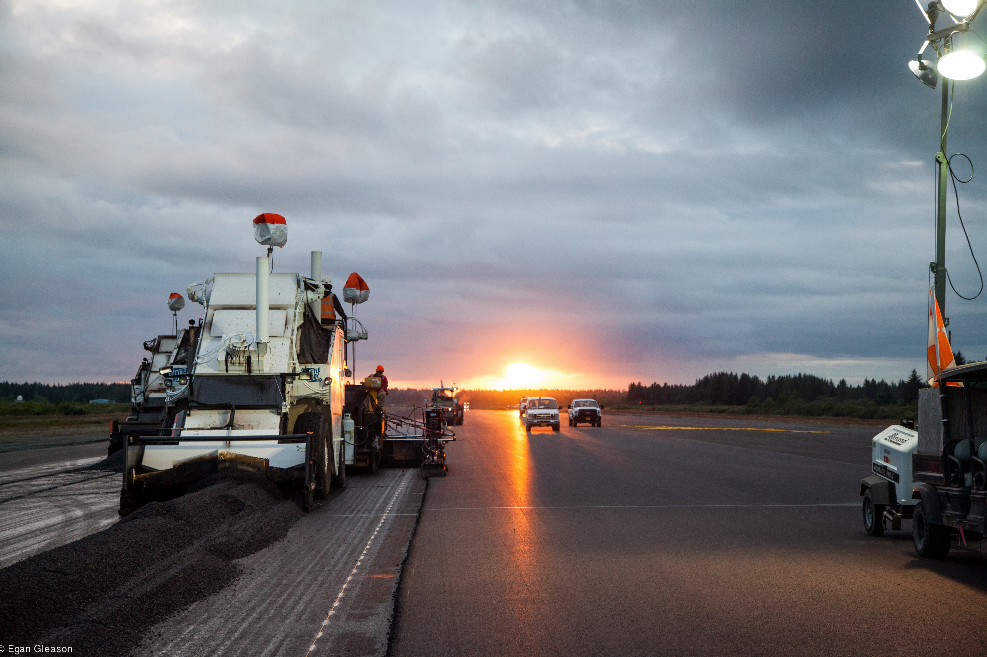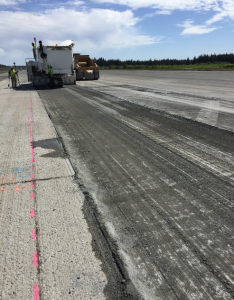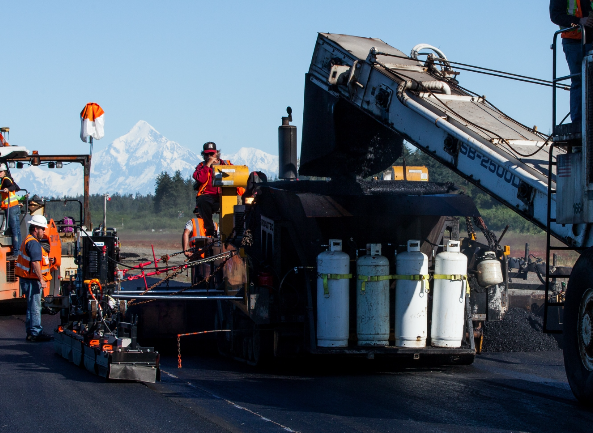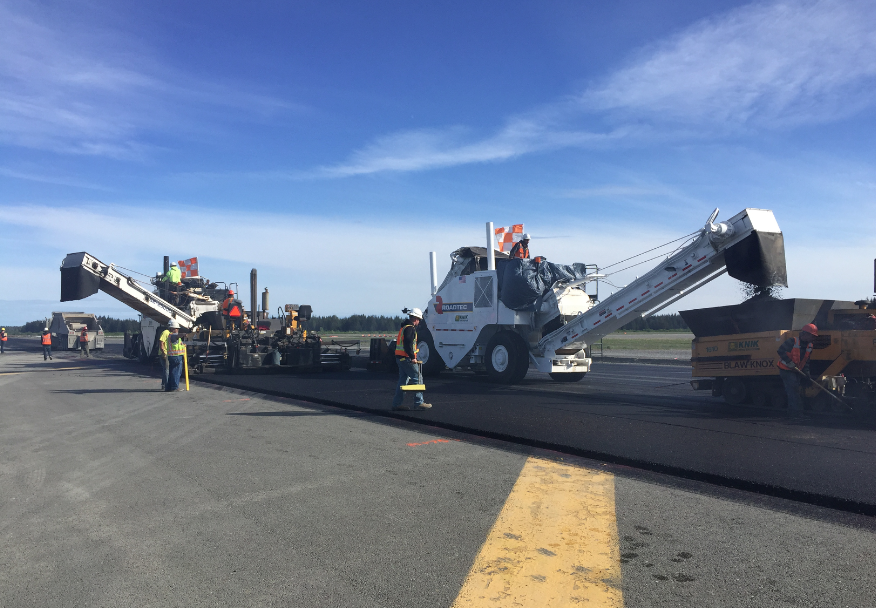Knik Construction Co. Delivers Remote Runway with Quality Bonus
BY Jeff Winke and Sandy Lender

Knik Construction Co. Inc., based in Anchorage, Alaska, states right up front on its website that it’s a heavy construction contractor that “specializes in complex, logistically challenging projects in hard-to-reach places.” Enter the Yakutat Airport (YAK) rehab project on the Inside Passage, where the company just achieved quality bonuses for the composition and density of its finished paved surface.
The Yakutat Chamber of Commerce describes the village as “located along the rugged Alaskan Gulf Coast between Sitka and Cordova. Bounded by the Gulf of Alaska on the South, nearly impenetrable mountains to the North, and coastal glaciers to the East and West, Yakutat is about as remote as one can get in Alaska. There are no roads leading into or out of Yakutat. All commerce and access must occur via air or sea.”
Such a description makes the Alaska Department of Transportation and Public Funding (ADOT&PF) Yakutat Airport runway pavement rehabilitation project all the more vital for a crew like Knik’s to get in, get done and get out in a timely fashion. YAK is a state-owned, public-use, two-runway airport located three nautical miles (6 kilometers) southeast of the central business district of Yakutat.
“Our project was the asphalt resurfacing of Runway 11/29,” Amanda Gilliland said. She’s a professional engineer and a project manager for Knik Construction. She explained that the runway project was 8,136 feet long by 194 feet wide, plus a 300-foot taxiway.
“For the project, the runway was divided into three sections,” she said.
The first section—about 2,400 feet—involved raising the 29 end, which tapered from the existing runway to an elevated 2.5 feet.

The Yakutat Airport rehabilitation project took place from May 1 to mid-August 2016. While the crew didn’t have to deal with permafrost, they did work around rain. This image can attest to some inclement weather. Amanda Gilliland, project manager for Knik Construction Co. Inc., explained they experienced “lots of rain, so we did cover our stockpiles to keep the aggregate dry. That lowers our fuel consumption.”
A middle section where the runways intersect required full depth removal to improve drainage.
The final section needed ½-inch surface milling, which she explained was enough to remove the texture grooves.

Some of the project needed ½-inch milling. The 3-worker milling crew used a Roadtec RX900e cold planer with GPS machine control.
The four-month project was a logistical challenge, which you’ll remember Knik revels in. “May 1 is when we started on the runway,” Gilliland shared. “Of course, we started processing aggregate in March.”
All of the aggregate they used for the project was local. To keep moisture out of stockpiles, thus drying costs under control, they kept stockpiles covered.
They also started planning early. All the heavy equipment, asphalt plant, supplies, and asphalt cement had to be shipped via barge, which came to Yakutat once a month.
“We needed to carefully plan our shipments, because if anything was forgotten, we were stuck until the next month’s barge, or we would need to fly it in,” Gilliland stated. “We had to ship all our asphalt cement via barge. Obviously you can’t fly it in because it was over 3,000 tons of material. Each cube of asphalt cement weighs about 27 tons. It also meant that we needed very reliable equipment with maintenance up to date—we wouldn’t want to send a truck over on the barge that needs new tires in a week.”

A set of four 100-pound propane tanks provides the fuel that heats the burners in a series along the joint. This process heats the longitudinal joint, helping the crew blend the new pass into what would otherwise be a cold joint. Notice that the joint matcher is behind the infrared heater so its heat doesn’t affect the readings. Best practice is to keep the infrared heaters about an inch and a half off the ground and slow the paving speed to about 12 feet per minute for adequate time to heat the joint. In 16 feet of 1.5-foot-wide infrared burners, you can get good coverage along the joint so each burner doesn’t have to linger too long.
Knik used a 400 TPH portable Astec double drum plant for this project. Gilliland explained that they didn’t purchase the plant for this job specifically, but have had it for several years. “We own and operate five different mobile drum mixing plants. We get temporary permits through DOT for the plants.”
The three-worker milling crew started things off. They used a Roadtec RX900e cold planer with GPS machine control, 12.5-foot cutting drum and Tier 4i Cat C27 engine to remove a total of 6,000 tons of millings. Those were mixed with 50 percent D-1 aggregate base and reused as fill on the section of the runway that required elevation to alleviate water issues.
“Working in a remote location, it is beneficial to try to reuse immediately rather than stockpile, since the pile could sit for years or longer before it would be used as fill or RAP,” Gilliland said.
For the Yakutat Airport runway, Knik delivered mix from the Astec plant located near the shipping docks 8 miles away in eight belly-dump haul trucks to two Roadtec SB-2500 Shuttle Buggy material transfer vehicles (MTVs), which were paired with two Blaw-Knox tracked pavers with hopper inserts at the runway site. Two paving crews with six workers each, plus eight locally-hired truck drivers, worked the job. For the most part, the existing 8 inches of asphalt runway served as the base for the new paving.
“Shuttle Buggies worked great—we rarely do any paving without them,” Gilliland said. “They give us consistency of HMA temperature and ensure against segregation…we’ve been using them a long time and, quite honestly, couldn’t imagine doing any large paving projects without them.”
According to Gilliland, the two MTVs kept both pavers productive and in instances where there wasn’t adequate space for the trucks to dump, the belly-dump could offload in another area and the Shuttle Buggy would pick up the pile and transport it back to the paver without having to stop paving. The Shuttle Buggy has 25 tons storage capacity.
“This was obviously not a common occurrence,” Gilliland shared. “The big one was the taxiway where we were tying into existing apron and runway.” To prevent over-dumping on an existing asphalt area they’d have to clean up, the crew elected to have the trucks dump in another, nearby location. “It was never far from the paving train,” Gilliland said. “It is just nice to have a mobile piece of equipment for certain situations like that.”

On a good production day, Knik Construction paved as much as 6,000 tons, leaving the top lift of the runway with very few transverse joints. Notice that by paving in echelon, the team created a hot joint that did not require any additional heating to get a good, smooth blend.
The Yakutat Airport project required 62,000 tons of HMA, making it the biggest paving project in Alaska for 2016. On a good production day, Knik Construction paved as much as 6,000 tons, leaving the top lift of the runway with very few transverse joints. The company used infrared cameras to shoot the pavement behind the screed to confirm no cold spots in the mat. Minimal color variation in the infrared image indicates minimal temperature difference in the mat.
“The Shuttle Buggy uses a triple auger mixing technology, which equalizes temperatures and evenly mixes large and small particles,” Gilliland said. “The asphalt spec for the job talks about the HMA temperature requirement and the thermal segregation penalty, and also the requirement of using an MTV on the job.”
Specifically, ADOT&PF requires the P-401 airport mix, and has a section discussing the use of an MTV for placing the surface course. “Direct transfer of asphalt concrete pavement from the hauling equipment to the paving machine will not be allowed during paving of the top layer. A self-propelled Material Transfer Vehicle equipped with remixing auger(s), (e.g. Roadtec Shuttle Buggy) shall be used to deliver the asphalt concrete pavement from the hauling equipment to the lead paver….The MTD/V shall distribute the asphalt concrete pavement on the prepared surface without segregation to obtain a smooth mixture of uniform temperature and texture throughout the finished surface.”
As the team completed the project, Gilliland said, “Even with the numerous rain delays, the challenging logistics getting equipment and supplies, we’re proud that we’re completing the largest asphalt paving project in the state this year and that we earned quality bonuses for the composition and density of our finished paved surface. This is definitely a unique project that all of us working on will remember for years to come.”
